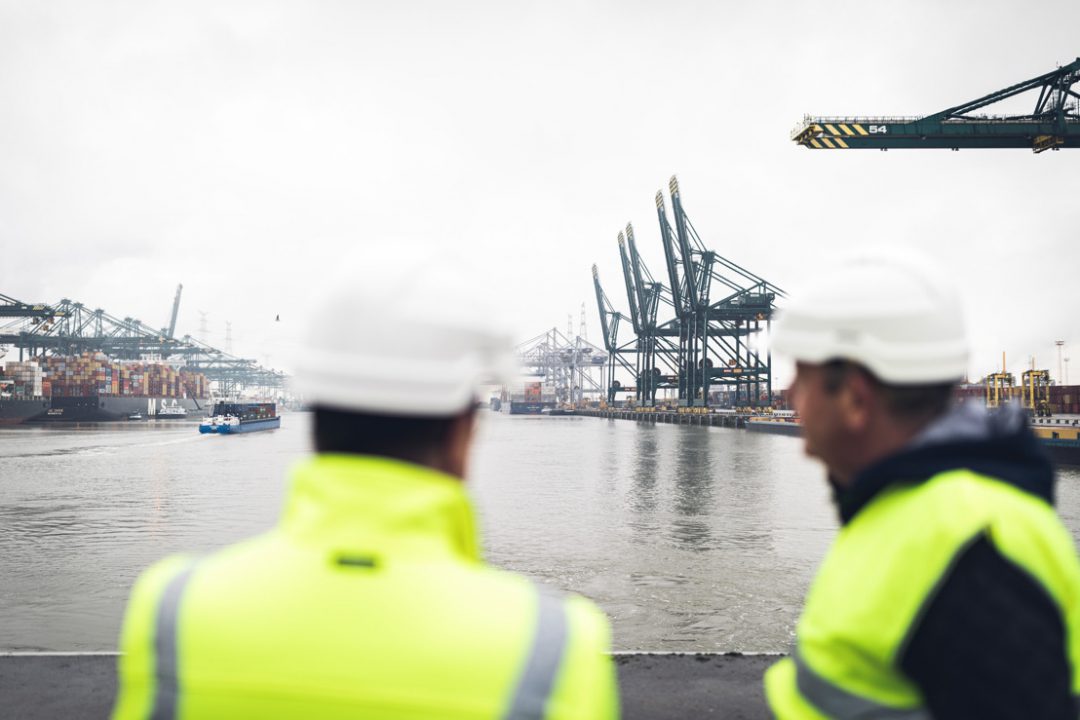The merger of the ports of Antwerp and Zeebrugge last year profoundly reshaped the Western European maritime landscape. The brand-new, unified port did not hide its ambitions. ‘We aim to become a world port that reconciles economy, people and climate,’ it said. New investments and projects confirm the attractiveness of the unified port – this being despite today’s difficult geopolitical context.
The unification significantly accelerated the already existing innovation and energy ambitions of both port authorities. After all, an increase in scale brings with it greater political and economic clout. This is how Port of Antwerp-Bruges is positioning itself today as a major player in the import, local production, processing and throughput of green hydrogen and hydrogen carriers (such as ammonia and methanol) to the hinterland. Some concrete hydrogen projects are now ready to be rolled out.
Over the past year, Port of Antwerp-Bruges has increasingly emerged as a crucial link in the international logistics chain. Today, for example, 15% of the total supply of LNG and natural gas to Europe arrives via the Zeebrugge port platform. One year earlier, this was about 8%. This makes Port of Antwerp-Bruges one of the main access routes for gas to the European hinterland. In terms of energy supply and transition, the merged port intends to continue its pioneering role in the future.
The integration process for transforming the various digital applications into a single system is well underway. Geographical data from the Zeebrugge platform has since been integrated into the Digital Twin (a virtual copy of the port), and real-time data (e.g. air quality sensors) has also been linked to it.
Container volumes
The fact that the ports can complement one another where necessary is reflected, among other things, in the shift of container volumes from Antwerp to Zeebrugge. Because Antwerp was at its limit in terms of container capacity last year, companies were able to divert to the Zeebrugge platform for their container handling. So container volumes can now be spread across two platforms – a win-win for both Port of Antwerp-Bruges and the logistics players.
Non-stop process
Both port platforms share some common challenges that they are now addressing together. Take, for example, the current shortages in the job market. Port of Antwerp-Bruges recently launched the jobs site www.havenjobs.com. By including vacancies from both Antwerp and Zeebrugge port authorities, the website reaches a broad Flemish audience. This expanded geographical reach gives a huge boost to the competitiveness and attractiveness of the port authorities in the job market.
After one year, Port of Antwerp-Bruges is still in transition and evaluating its processes and systems non-stop. A merger is a long-term project and involves some major challenges – technical, operational and human. Port of Antwerp-Bruges can look back, as well as forward, with satisfaction. The port platforms – and especially the people behind them – have joined forces, helped shape the merger story and made it happen.
Dirk De fauw, Mayor of the City of Bruges and Vice President of Port of Antwerp-Bruges, said: ‘The merger is a win-win and an added value for both Zeebrugge and Antwerp. Now, a year after the effective merging of the two ports, we see this very clearly in the figures. This added value was also evident in their joint performance abroad, which was much appreciated by the port clientele, such as the princely missions to the United Kingdom, the US and Japan, and the visit of the King and Queen to the port of Duqm in Oman. I am convinced that this feeling will only accelerate and intensify in the future. We have a port here that we can be proud of, because we are the first world port that has an ambition to reconcile economy, people and climate.’
Annick De Ridder, Port Alderwoman of the City of Antwerp and Chairwoman of the Board of Directors of Port of Antwerp-Bruges: ‘Our merged port is a world port that is ensuring sustainable growth and economic prosperity. It harbours great ambitions, while facing great challenges. Those challenges we successfully faced together in the ‘birth year’ with resilience and agility. Meanwhile, the merger of the highly complementary port platforms is proving its added value in practice. Our merged port is the economic engine of Flanders. And that engine keeps running thanks to all the hard work of all the employees, both on the Antwerp and Zeebrugge port platforms.’
Jacques Vandermeiren, CEO of Port of Antwerp-Bruges: ‘After one year, we are not only one port. Today, one year later, I also see in the workplace every day how we have grown into one cohesive management and one cohesive team. The fact that we thus form one port together, which is also holding strong in geopolitically and economically challenging times and during the energy crisis, can also count on a great deal of international resonance.’

























